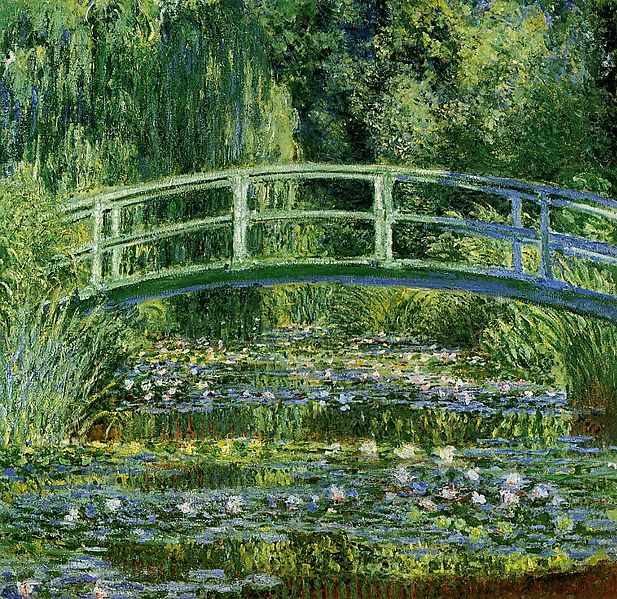Image: Water-Lilies-and-Japanese-Bridge-(1897-1899)-Monet

Description: Catalogue Entry: Water Lilies and Japanese Bridge represents two of Monet’s greatest achievements: his gardens at Giverny and the paintings they inspired. Monet moved to Giverny in 1883 and immediately began to develop the property. For him, the gardens were both a passion and a second artistic medium. His Asian garden was not part of the original estate; it was located on an adjacent property with a small brook, which he purchased and enlarged into a pond for a water garden in 1893. He transformed the site into an inspired vision of cool greens and calm, reflective waters, enhanced by exotic plants such as bamboo, ginkgo, and Japanese fruit trees and a Japanese footbridge. It was not until 1899, however, that he began a series of views of the site, of which this is one. A careful craftsman who reworked his canvases multiple times, Monet was committed to painting directly from nature as much as possible and for as long as he had the correct conditions; thus, he could work on as many as eight or more canvases a day, devoting as little as an hour or less to each. In this case, he set up his easel at the edge of the water-lily pond and worked on several paintings of the subject as part of a single process. Monet’s gardens and paintings show the same fascination with the effects of time and weather on the landscape. Both are brilliant expressions of his unique visual sensitivity and emotional response to nature. At Giverny, he literally shaped nature for his brush, cultivating vistas to paint. Gallery Label: Water Lilies and Japanese Bridge represents two of Monet’s greatest achievements: his gardens at Giverny and the paintings they inspired. In 1883 the artist moved to the country-town Giverny, near Paris but just across the border of Normandy. This was a time when he was enjoying increasing financial success as an artist, and he immediately began to redesign the property. In 1893, Monet purchased an adjacent tract, which included a small brook, and transformed the site into an Asian-inspired oasis of cool greens, exotic plants, and calm waters, enhanced by a Japanese footbridge. The serial approach embodied in this work—one of about a dozen paintings in which Monet returned to the same view under differing weather and light conditions—was one of his great formal innovations. He was committed to painting directly from nature as much as possible and whenever weather permitted, sometimes working simultaneously on eight or more canvases a day. Monet’s project to capture ever-shifting atmospheric conditions came to be a hallmark of the Impressionist style.
Title: Water Lilies and Japanese Bridge
Credit: the-athenaeum.org [1]
Author: Claude Monet
Permission: This is a faithful photographic reproduction of a two-dimensional, public domain work of art. The work of art itself is in the public domain for the following reason: The author died in 1926, so this work is in the public domain in its country of origin and other countries and areas where the copyright term is the author's life plus 80 years or less. You must also include a United States public domain tag to indicate why this work is in the public domain in the United States. Note that a few countries have copyright terms longer than 80 years: Mexico has 100 years, Jamaica has 95 years. This image may not be in the public domain in these countries, which moreover do not implement the rule of the shorter term. Côte d'Ivoire has a general copyright term of 99 years, but it does implement the rule of the shorter term. This file has been identified as being free of known restrictions under copyright law, including all related and neighboring rights. The official position taken by the Wikimedia Foundation is that "faithful reproductions of two-dimensional public domain works of art are public domain". This photographic reproduction is therefore also considered to be in the public domain in the United States. In other jurisdictions, re-use of this content may be restricted; see Reuse of PD-Art photographs for details.
Usage Terms: Public domain
License: Public domain
Attribution Required?: No
Image usage
The following 2 pages link to this image:

